Designed for Performance
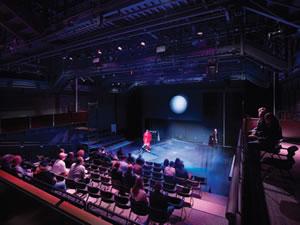
PHOTO © HALKIN MASON PHOTOGRAPHY
It was 2009 and Mark Gearan, president of Hobart and William Smith Colleges (HWS), was in an admissions mode.
“We were losing good students to other top liberal arts colleges,” Gearan says. “Our admissions office knew it. Our board of trustees knew it. We had talented students in the performing arts; all we were lacking was the facility.”
At that time, studies in music, dance, theater and film were dispersed across the 195-acre lakeside campus in upstate Geneva, NY, known as one of the most picturesque in the country. Professors in the respective fields barely saw each other, let alone were they able to collaborate and synergize their programs. Music students had to lug heavy instruments about, with little space to store them safely.
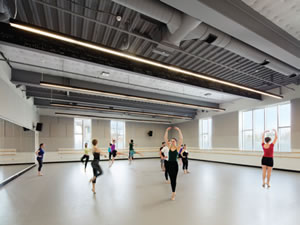
PHOTO © HALKIN MASON PHOTOGRAPHY
“It was a horror show,” says Chris Woodworth, associate professor of Theater.
Under Gearan’s leadership, the school began planning for the largest building project in its history: a 65,000-squarefoot, $31.5 million performing arts center, located strategically at the entrance to the campus. After a search for an architect, the colleges hired GUND Partnership of Cambridge, MA, to design the center. Multiple sites were considered, and each performing arts discipline was studied to determine the feasibility of bringing them all together under one roof. All the while, GUND kept the momentum going in collaboration with Gearan and his assigned task force.
A FACILITY FOR COLLABORATION
The new building, which opened in February 2016, has had a demonstrably positive impact on student achievement by raising pedagogical standards, improving student employability, increasing interest in performing arts majors, recruiting better faculty and students and fostering interdisciplinary collaboration.
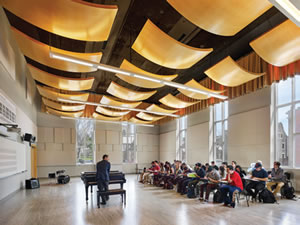
PHOTO © HALKIN MASON PHOTOGRAPHY
“I am able to ask for a higher quality of work,” says Cadence Whittier, professor of Dance at the colleges. “As a dancer and choreographer, I am now able to create choreography in the space in which it is going to be performed. We’re all, students and faculty, producing better work.”
The building, Gearan and interviewed faculty agree, is a visible commitment on the part of HWS to the liberal arts in general and the performing arts in particular. It has galvanized interest in the performing arts among students far and wide. Example: more students than ever are interested in majoring in performing arts and competing for HWS’ performing arts scholarships, and students are graduating with more employable skills.
“We’re starting to see more students come to HWS to study theater,” says Woodworth.
“Students are coming out of here,” she continues, “with a host of skills. Our graduates have found very prominent positions in the theater. The building has engendered confidence.”
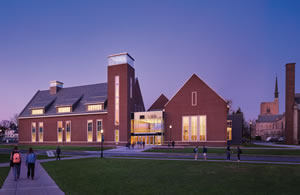
PHOTO © HALKIN MASON PHOTOGRAPHY
The Gearan Center for the Performing Arts, named after Mark Gearan and his wife Mary Herlihy Gearan, celebrates the diverse architecture of the HWS campus. It has a large, light-filled central lobby, around which are arrayed spaces for each of the performing arts disciplines — music, dance, theater and film. The lobby was designed to bond the disciplines as an equivalent of the community living room that accommodates impromptu student/faculty interaction and even spontaneous performances.
BUILT FOR PERFORMANCE
The building’s location puts it at the campus’ crossroads. On the exterior, the steeply angled roofs acknowledge the upstate New York winters. A cupola and 80-foot glass-topped tower, which marks the entrance, flood the interior with natural light and provide inspired interior spaces for teaching. The Flemish bond brick pattern celebrates the Flemish revival buildings on the campus.
Assistant Professor of Music Katherine Walker credits the impeccable acoustics of the center’s spaces and rehearsal rooms for higher student achievement. “You can only ask a student to perform what they hear. The acoustics mean students will reach a higher level.”
Walker credits the building for being “a big part of what attracted me to this job.”
In addition to fostering student excellence, the Gearan Center has made it possible for more student/student and student/faculty engagement.
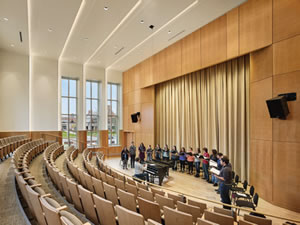
PHOTO © HALKIN MASON PHOTOGRAPHY
“There are more collaborative efforts between students,” Walker says. “We get dancers wanting to study music, musicians who want to try theater, and so on.” Dance professor Whittier concurs: “Before, my students rarely sought out their theater and music peers.”
“The everyday camaraderie has fostered collaborations among faculty,” Woodworth says.
Faculty offices are deliberately placed together on the building’s second and third floors, precisely to engender this kind of interaction. “Before, because we were separated on campus, we had to seek each other out,” says Whittier.
OFFERING WELCOME TO ALL
Gearan Center is designed to be inclusive, welcoming all students to enter and learn and be engaged.

PHOTO © HALKIN MASON PHOTOGRAPHY
“We do a disability arts festival,” Whittier says. “We have a gender-neutral bathroom.” She adds that major performance spaces were initially going to be located on upper floors. “We told the architects that would not be inclusive, and they listened and made the appropriate design changes.”
Because of the nature of the performing arts, the Gearan Center attracts people from the wider Geneva community who come and partake of what the building offers.
“We have a deep and personal connection to the community,” says Woodworth. “I grew up in Geneva. I see citizens come in to watch rehearsals or live performances. We also welcome visiting artists from New York City and other places. People come here and say, ‘I can’t believe you have this space in Geneva.’”

PHOTO © HALKIN MASON PHOTOGRAPHY
The design of the building enhances the occupants’ experience, be they students, faculty, visitors or Geneva citizens. The main performance spaces are acoustically isolated from each other, assuring classes and performances can go on simultaneously without disturbance. Tall windows are not just an architectural signature, but allow views to the outside and beckon passersby to enter.
President Mark Gearan wrapped up an 18-year tenure as head of the colleges over the summer, making him the longest-serving president in the colleges’ history. A former director of the Peace Corps and director of communications during the Clinton administration, Gearan says he was grateful to have his and his wife’s name over the door at the Gearan Center.
“This is the honor of a lifetime,” he says. This fall Gearan begins a stint as president in residence at the Harvard University Graduate School of Education. But the legacy of Gearan Center will continue.
“The performing arts are at the heart of a liberal arts education,” Gearan says. “The center raises the bar for student achievement.”
This article originally appeared in the issue of .